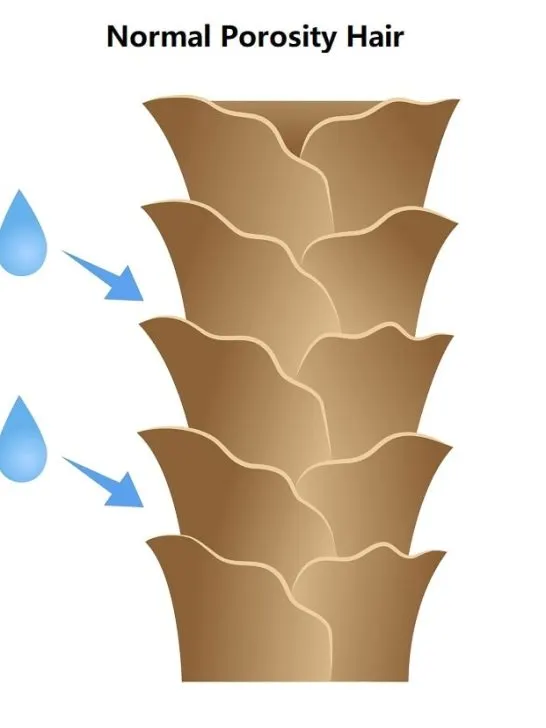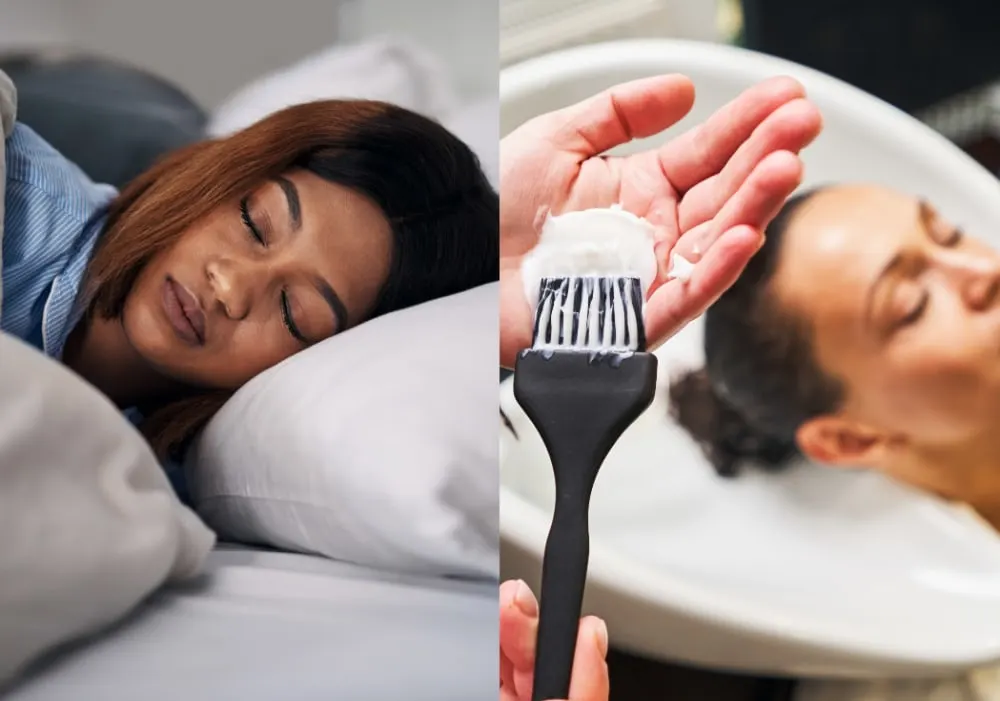You’ve probably seen videos of people putting a few strands of hair into a glass of water for a minute to see if it sinks (high porosity) or floats (low porosity). No doubt, you’ve heard a lot about hair porosity.
But is relaxed hair porosity the same as virgin hair porosity? We’ll answer that question below so you can see whether you need to do the porosity test.
Is Relaxed Hair Low or High Porosity?
Unfortunately, relaxed hair is almost always high porosity, so there’s no need to test your hair to check if it might be low porosity.
Hair relaxing chemicals are very alkaline, softening the hair cuticle a great deal and lifting it wide. For most people, the hair cuticle does not recover from such treatment. It never fully closes and hardens again. So relaxed hair takes heat styling and hair dyes easily. But it also tends to be very dry and suffers from breakage.
What is Low Porosity Hair?

Low porosity hair has the protective layer of the hair, the hair cuticle, clamped shut. The hair cuticle can also be thicker for low porosity hair, making your hair strands thicker in diameter, too.
It’s difficult to get moisture inside a hair cuticle that’s tightly closed, but once you do, it stays for a long time. Low porosity hair is typically virgin hair that hasn’t had any chemical or heat processing done to it.
It’s healthy in the extreme and might even be resistant to heat and chemicals in the same way that it’s resistant to water. However, you only need a little steam to open the hair cuticles of low porosity hair and allow moisture to enter the inner hair shaft.
You probably had low porosity hair as a kid. And whoever styled it complained because she couldn’t do much but braid it or put it into a ponytail.
If she straightened it, it was back in a curly or coily state within hours. But eventually, it conformed and became easier to style. At that point, you had normal or high porosity hair.
What is Normal Porosity Hair?

Normal hair porosity is when your hair easily accepts moisture, conditioning, heat styling and chemicals. The hair cuticle has been worn down a bit from daily styling or heat.
Your hair isn’t damaged yet, but it’s not resistant to chemicals and heat styling anymore. It’s pliable, and the hair cuticle opens easier than when your hair was low porosity.
What is High Porosity Hair?

High porosity hair is damaged hair. This is hair in which the hair cuticle has been worn away in parts or the cuticle is so far open that moisture enters and escapes easily. When stylists think of high porosity hair, they usually think of hair that’s been bleached.
That’s because bleach is one of the harshest chemical processes. It leaves the hair cuticle open and your tresses prone to extreme dryness. Relaxing treatments are a close second to bleach in harshness.
How to Care for High Porosity Relaxed Hair

There are a few ways you can care for your high porosity relaxed hair to make it healthier and less prone to breakage:
Sleep on silk. Use a silk scarf or pillowcase, but never sleep directly on cotton if you can help it. Cotton sucks the moisture out of your hair. So if it was dry before you laid down, it will be like straw when you wake up.
Avoid heat styling. Relaxers straighten hair, but not completely. They also leave the hair stiff. So if you want it to flow in the breeze, you’ll need a blowout treatment. But these can be damaging. Try to limit blowouts to once a week and use a silicone-based heat protectant to seal it from humidity and keep it flowing. Whatever you do, don’t use a curling iron or flat iron daily.
Use protein treatments. Once a week, before washing your hair, do a deep conditioning treatment with protein. Luckily, these days, most protein treatments are balanced with sufficient moisture, so they don’t dry your hair out.
If you leave the treatment in your hair for a few hours, the protein will bind temporarily to the areas of the hair cuticle that are missing the protective shingles. This lessens the chance that your hair will break in those areas where it’s missing the hair cuticle.
Related Topics
- Can I Bleach My Relaxed Hair?
- How to Protect Relaxed Hair from Breakage and Damage
- How to Dye Relaxed Hair Without Damage
- What Happens if You Stop Relaxing Your Hair?
- How to Moisturize Relaxed Hair Without Weighing It Down
